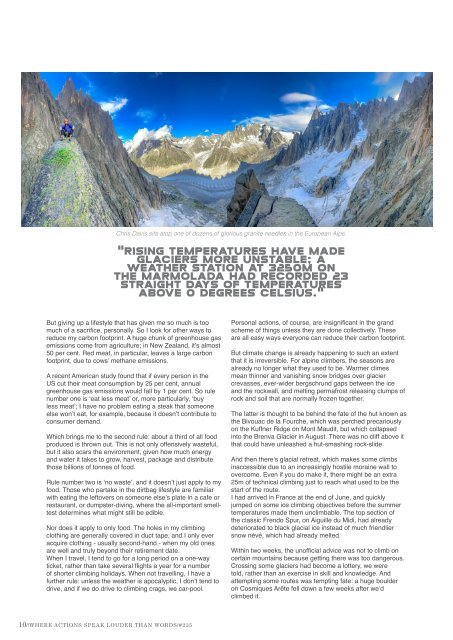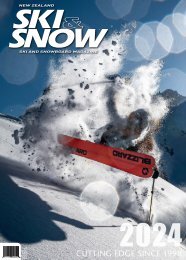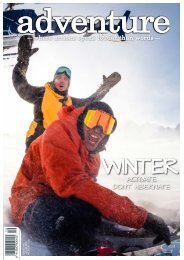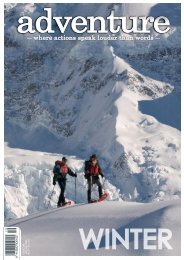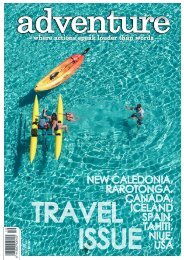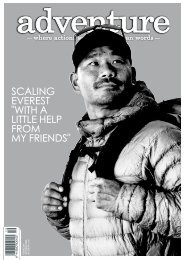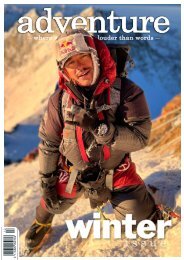Adventure Magazine
Issue #236 Xmas 2022
Issue #236
Xmas 2022
Create successful ePaper yourself
Turn your PDF publications into a flip-book with our unique Google optimized e-Paper software.
Chris Davis sits atop one of dozens of glorious granite needles in the European Alps.<br />
"rising temperatures have made<br />
glaciers more unstable; a<br />
weather station at 3250m on<br />
the Marmolada had recorded 23<br />
straight days of temperatures<br />
above 0 degrees Celsius."<br />
But giving up a lifestyle that has given me so much is too<br />
much of a sacrifice, personally. So I look for other ways to<br />
reduce my carbon footprint. A huge chunk of greenhouse gas<br />
emissions come from agriculture; in New Zealand, it’s almost<br />
50 per cent. Red meat, in particular, leaves a large carbon<br />
footprint, due to cows’ methane emissions.<br />
A recent American study found that if every person in the<br />
US cut their meat consumption by 25 per cent, annual<br />
greenhouse gas emissions would fall by 1 per cent. So rule<br />
number one is ‘eat less meat’ or, more particularly, ‘buy<br />
less meat’; I have no problem eating a steak that someone<br />
else won’t eat, for example, because it doesn’t contribute to<br />
consumer demand.<br />
Which brings me to the second rule: about a third of all food<br />
produced is thrown out. This is not only offensively wasteful,<br />
but it also scars the environment, given how much energy<br />
and water it takes to grow, harvest, package and distribute<br />
those billions of tonnes of food.<br />
Rule number two is ‘no waste’, and it doesn’t just apply to my<br />
food. Those who partake in the dirtbag lifestyle are familiar<br />
with eating the leftovers on someone else’s plate in a cafe or<br />
restaurant, or dumpster-diving, where the all-important smelltest<br />
determines what might still be edible.<br />
Nor does it apply to only food. The holes in my climbing<br />
clothing are generally covered in duct tape, and I only ever<br />
acquire clothing - usually second-hand - when my old ones<br />
are well and truly beyond their retirement date.<br />
When I travel, I tend to go for a long period on a one-way<br />
ticket, rather than take several flights a year for a number<br />
of shorter climbing holidays. When not travelling, I have a<br />
further rule: unless the weather is apocalyptic, I don’t tend to<br />
drive, and if we do drive to climbing crags, we car-pool.<br />
Personal actions, of course, are insignificant in the grand<br />
scheme of things unless they are done collectively. These<br />
are all easy ways everyone can reduce their carbon footprint.<br />
But climate change is already happening to such an extent<br />
that it is irreversible. For alpine climbers, the seasons are<br />
already no longer what they used to be. Warmer climes<br />
mean thinner and vanishing snow bridges over glacier<br />
crevasses, ever-wider bergschrund gaps between the ice<br />
and the rockwall, and melting permafrost releasing clumps of<br />
rock and soil that are normally frozen together.<br />
The latter is thought to be behind the fate of the hut known as<br />
the Bivouac de la Fourche, which was perched precariously<br />
on the Kuffner Ridge on Mont Maudit, but which collapsed<br />
into the Brenva Glacier in August. There was no cliff above it<br />
that could have unleashed a hut-smashing rock-slide.<br />
And then there’s glacial retreat, which makes some climbs<br />
inaccessible due to an increasingly hostile moraine wall to<br />
overcome. Even if you do make it, there might be an extra<br />
25m of technical climbing just to reach what used to be the<br />
start of the route.<br />
I had arrived in France at the end of June, and quickly<br />
jumped on some ice climbing objectives before the summer<br />
temperatures made them unclimbable. The top section of<br />
the classic Frendo Spur, on Aiguille du Midi, had already<br />
deteriorated to black glacial ice instead of much friendlier<br />
snow névé, which had already melted.<br />
Within two weeks, the unofficial advice was not to climb on<br />
certain mountains because getting there was too dangerous.<br />
Crossing some glaciers had become a lottery, we were<br />
told, rather than an exercise in skill and knowledge. And<br />
attempting some routes was tempting fate: a huge boulder<br />
on Cosmiques Arête fell down a few weeks after we’d<br />
climbed it.<br />
10//WHERE ACTIONS SPEAK LOUDER THAN WORDS/#235


